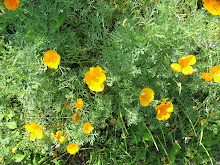The top 5 successful plants in my plot:
1. basil
3. Sungold tomatoes*
4. eggplant*
5. California poppies
The top 5 failures:
1. watermelon* (my daughter really wanted to grow it, but I had my doubts)
2. bell pepper*
3. fall lettuces* (Bibb and Romaine, planted too late)
4. the other heirloom tomatoes* I planted (some had ripened but not without rot, catfacing or other problems)
5. Scarlet Nantes carrots (they had been covered for a while by squash leaves from a neighbor's plot, and I harvested only about a half dozen)
*started in pots by others, and transplanted
Resolutions for 2009:
1. Provide more supports for tomatoes, especially large varieties like Brandywine.
2. Contain the strawberries so they don't spread like crazy.
3. Grow the following: green beans (haven't head of any Mexican bean beetle infestations lately, and Curtis's crop left me envious), spinach, brussel sprouts, and broccoli (mildly successful in my backyard, would like more).
4. Skip the following: peppers (not reliable), carrots (not reliable plus cheap to buy anyway), and some squash varieties that take up too much space.
5. Start more plants indoors and sow more varieties into the plot, when possible.
6. Mulch earlier to combat the spread of pigweed and other weeds. Try to find salt hay before it becomes scarce.
7. Plug some important gardening reminders into my calendar (such as starting my fall lettuce earlier, from seed).
8. And finally, keep up the blog. The exercise in blogging has helped me expand my knowledge of gardening and connect with other gardeners. Now that I have a better camera (a Christmas present) and some experience, I hope to reach out to more gardeners and deliver more informative and relevant posts.
Happy New Year! If you have any thoughts or resolutions, please share them.

































